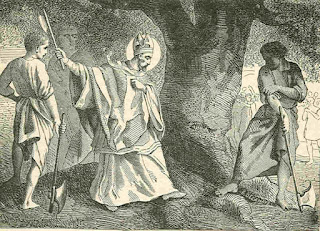There were difficulties in building, according to an account by Pope Gregory II. Satan made a rock too heavy to move by sitting on it until Benedict shooed him away, and collapsed a wall on a young monk whom Benedict had to bring back to life. It was common in hagiographies to relate how the subject overcame pagan or demonic opposition.
Benedict's time at Monte Cassino was not long. He died in 534 and was buried in the oratory of St. John on the site. The monastery itself was sacked by Lombards in 570, and abandoned.
A second monastery was established on the site in 718 by Petronax of Brescia. He was an Italian monk who made a pilgrimage to the tomb of Benedict and found a few hermits living at Monte Cassino. They asked him to lead them; donations from nobles like the Duke of Benevento allowed them to rebuild. St. Willibald and St. Sturm of Fulda were at Monte Cassino under Petronax. Once again, however, the monastery was a target, this time in 883 by Saracens. The monks of Monte Cassino re-located to Teano and then Capua until 949, when Monte Cassino was rebuilt.
Monte Cassino experienced a golden age in the 11th and 12th centuries. It acquired much land in the area, referred to as the Land of Saint Benedict (ultimately reaching 80,000 hectares) which afforded it much material wealth. The abbey had art from Byzantine and Islamic artisans and received patronage from Byzantine emperors. Three popes came from Monte Cassino during this period.
It started to close independence and authority in the 13th century. Emperor Frederick II garrisoned troops there in his war with the pope. An earthquake in 1349 collapsed most of the buildings. Pope Urban V demanded funds from all Benedictine monasteries toward rebuilding Monte Cassino in 1369.
In 1799, Monte Cassino was sacked by the French Revolutionary Army. In 1866 it was declared a national monument with the monks as custodians. In 1944, it was destroyed by American bombers on the mistaken belief that German troops were stationed there. It was rebuilt, currently housing about a dozen monks.
During the time that the monks were "in exile" at Teano and Capua, the original Rule of St. Benedict was influenced by the Cluniac Reforms, sometimes also called the Benedictine Reforms. What were they, and how did they change the lives of monks? We will explore that next time.



